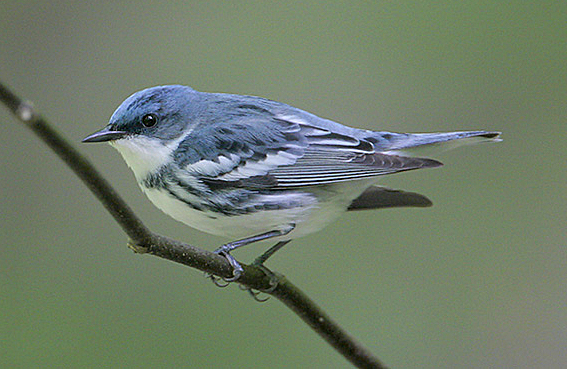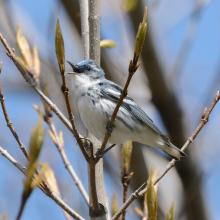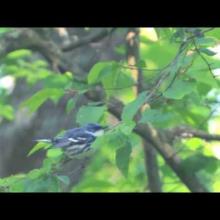

Join BirdNote tomorrow, November 30th!
Illustrator David Sibley and actor H. Jon Benjamin will face off in the bird illustration battle of the century during BirdNote's Year-end Celebration and Auction!
Did you know that the United States shares many migratory songbird species with our neighbors in Central and South America?
Follow us along the migratory path of the beautiful Cerulean Warbler. And learn what the Rainforest Alliance is doing to conserve the bird’s breeding habitat in Appalachia and its wintering habitat in the forests and coffee farms of Colombia.
Appalachian Woodlands
The lush Appalachian woodlands of the southeastern United States are an ecological treasure, home to more than 200 globally rare plants and animals. More than 15,000 documented wildlife species, including the caribou, moose, black bear, wild boar, fox, and numerous small mammals thrive here. The Appalachian region is home to more salamander species than anywhere else in the world.

And like all living forests, the Appalachian woodlands are the lungs of the region, providing oxygen while also absorbing greenhouse gases and stabilizing the local climate. They provide safe drinking water and clean air for millions of people.
Forest and Coal Country
Nearly 60 percent of Appalachian forests are owned and managed by private landowners—families, small businesses, or a single person—who regard their forest as a living asset for recreation, refuge, and income generation. While many private woodland owners across the region have an excellent record of forest stewardship, irresponsible timber harvesting has been the norm, rather than the exception, for decades. These forests are also being decimated for mountaintop removal for coal mining.
Appalachia: Strong Forests for Strong Communities
To address these pressures on a critically important US landscape, the Rainforest Alliance has joined with businesses, foresters, the US Forest Service, and landowners in the southeastern United States to form the Appalachian Woodlands Alliance (AWA). The AWA works to conserve this forestland and enhance the local economy by advancing sustainable forest management practices tailored to local needs. These practices include the creation of vegetative buffers alongside waterways to enhance water quality, the management of invasive species, and the improvement of high-value habitats, including those that host migratory birds and other wildlife species.
Take a look at this video that highlights how Rainforest Alliance is working to balance sustainable use and protection of Appalachia.
A Refuge for Migratory Birds
Appalachia’s forests provide critical stopover refuge for migratory birds. The birds spend their breeding season in Canada and the United States and fly hundreds of miles south to winter in Mexico and Central and South America. These species include the Baltimore Oriole, Broad-winged Hawk, Red-eyed Vireo, Ruby-throated Hummingbird, Scarlet Tanager, Tennessee Warbler, and the Cerulean Warbler.
Cerulean Warblers spend the breeding season—late April through August—across the Midwest and southeastern regions of the United States, into Quebec and Ontario in Canada. They favor mature deciduous forests, those mostly made up of trees that lose their leaves each year. The birds eat insects and forage high up in the trees, moving rapidly from limb to limb in search of food. Although sizeable populations can be found throughout their migratory range, approximately 80 percent of the Cerulean Warbler population breeds in the forests of Appalachia in Tennessee, Kentucky, West Virginia, Ohio, and Pennsylvania.
In August, Cerulean Warblers begin their amazing journey south, flying across the Gulf of Mexico to the highlands of Central America. They’ll finally settle for the winter in the tropical Andean forests of Colombia, Venezuela, Ecuador, and Peru. Throughout their migratory range, birds depend on high-quality habitats with lots of available food so they can develop the fat deposits they need to fuel their journey.
Cerulean Warblers winter in Andean sub-montane forest, mainly between 3,280 – 6,562 feet (1,000 - 2,000 meters). Shade coffee plantations in Colombia are a critically important wintering habitat, supporting densities of warblers 3 to 14 times higher than those of neighboring primary forest. Shade coffee farms that have natural forest canopy provide migratory and resident birds with food sources in the form of insects and fruit nectar. These farms also provide important ecological services, such as erosion prevention, the protection of fresh water sources, soil nourishment, and carbon storage.
Shade Coffee Farms: Important Bird Habitat
There are more than 24,000 Rainforest Alliance Certified™ coffee farms, covering 452,000 acres (182,000 hectares) within the species’ wintering habitat in South America. In Colombia, there are more than 13,600 certified farms covering more than 280,500 acres (113,550 hectares).
On Rainforest Alliance Certified™ farms, coffee grows in harmony with nature: soils are healthy, waterways are protected, trash is reduced or recycled, and migratory bird habitat flourishes. The sustainable agriculture certification standard prohibits the clearing of any forestland for agricultural expansion, and it requires the conservation of on-farm natural habitat. It also includes requirements for shade cover and the number of tree species per hectare for agroforestry crops.
As a result of the training programs and certification systems, more than 1.3 million farmers are now using responsible methods that protect wildlife habitat—such as composting, the planting of native trees among shade-friendly crops, and manual and biological pest control. Farmers and wildlife also benefit from watershed conservation, buffer zones along streams to prevent erosion, and biological corridors for migratory species.
BirdNote is grateful to the Rainforest Alliance for sharing this information as part of our efforts to #BringBirdsBack.
Listen to these BirdNote shows to learn more about Cerulean Warblers and other birds that depend on Appalachia’s forests during migration:
Cerulean Warblers Link Conservation on Two Continents
World of Warblers
Recording Cerulean Warblers with Charlotte Goedsche
The Baltimore Oriole
How Much Birds Sing
Audubon and the Ruby-throated Hummingbird
Scarlet Tanagers Under the Canopy
Tanagers – Coffee Birds
Learn more about the Rainforest Alliance’s work:
Issues
Regions
What the Rainforest Alliance seal means
This blog was originally published on www.rainforest-alliance.org.


